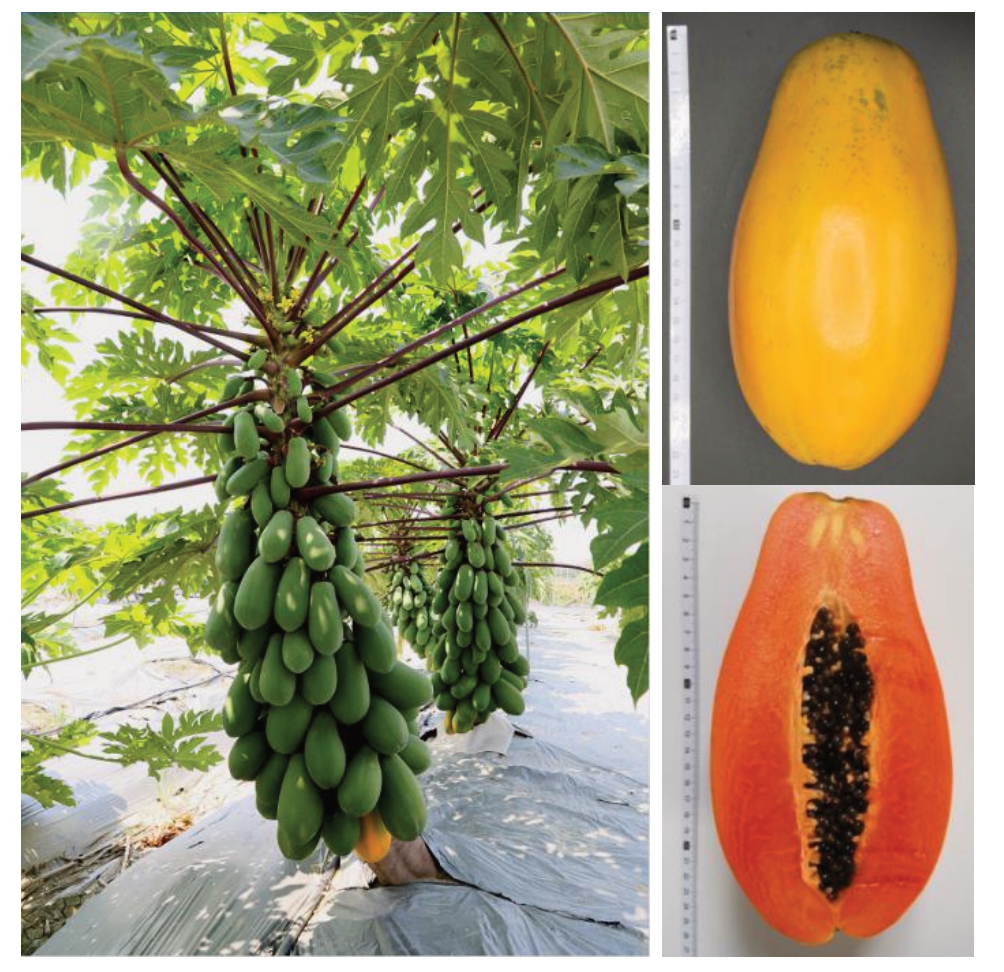番木瓜(Carica papaya L.)隶属于番木瓜科(Caricaceae)番木瓜属(Carica),是热带、亚热带地区最重要的果树作物之一[1],果实富含维生素和矿物质,钠、脂肪和卡路里含量低,无淀粉[2],以其营养和药用价植闻名于世[3],被世界卫生组织列为最有营养价植的十大水果之首[4]。
番木瓜为多年生草本果树,通常在定植后第2年进入丰产期,但毁灭性病害番木瓜环斑花叶病毒病(PRSV)往往导致定植后第2 年开始大幅减产甚至绝收[5],成为制约番木瓜产业发展的主要瓶颈。由于番木瓜属种质资源具有遗传背景狭窄、种内抗性资源缺乏、属间不亲和的特性,通过常规杂交育种难以改善番木瓜的抗逆性[2,6]。因此,培育丰产优质番木瓜新品种,研发优质高效配套栽培技术,实现当年定植、当年丰收的目的,成为当前番木瓜常规育种和产业发展的重点方向。
1 选育经过
2016年7月以泰国红两性株为母本、小果型夏威夷类GZ201301301 两性株为父本,通过常规杂交方式得到杂交种子358粒,12月播种后培育获得F1代健康种苗296株。2017年2月定植于白云区钟落潭镇育种基地,4月底始花挂果。经筛选和综合评价,获得植株生长速度快、生长势强、挂果早、结果部位低、连续结果能力强、果皮光滑、果形好、产量高、品质优良的两性株优系GZ16-2。为避免该优系感染环斑花叶病毒病,并尽快获得无性系种苗,缩短育种周期,于2017年12月采取搭建独立简易温室的方式对优系单株进行保护,覆盖塑料薄膜和防虫网。将该优系于离地1 m处截干,低温期辅助加热,促进侧芽萌发,保证侧芽在低温期的正常生长。所获得的侧芽部分被用于嫁接以获得嫁接苗,部分被用于种苗的组织培养快繁以获得组培苗,分别于2018年3月和9月定植在广州市天河区和白云区试验基地,进行品种比较试验。2019—2020年,于广州市、佛山市、湛江市等地开展多年多点试验。经综合评价,GZ16-2 遗传性状稳定,具有适应性强、生长势旺盛、结果早、结果部位低、连续坐果能力强、早熟、商品性状优良、商品果率高和丰产优质等特点。2021 年8 月通过广东省农作物品种审定委员会品种评定(评定编号:粤评果20210009),定名为紫晖番木瓜(图1)。

图1 优质丰产番木瓜新品种紫晖
Fig.1 A new papaya cultivar Zihui with good quality and high yield
2 主要性状
2.1 植物学特征
植株壮旺,冠幅约290 cm,株高260 cm。茎干呈圆柱形,灰紫色,内中空,茎干高195 cm,粗45 cm。叶片大,叶长90 cm,宽93 cm,呈掌状缺刻状,缺刻深度中,无旗叶,颜色浓绿,叶脉清晰且呈浅紫色,叶片较厚而有光泽。叶柄粗大,呈深紫色,叶柄长约102 cm,粗11 cm。始花节位数19.3 节,花序主轴呈紫色,平均长约7.5 cm,花数量多,花冠紫色,花瓣黄色,花冠长度约3.4 cm。
2.2 主要经济学特性
结果部位低,最低结果高度34.5 cm,连续坐果能力强,节位坐果率为92.2%,定植当年单株收获果实数量61.8 个,其中商品果56.4 个,商品果率为91.3%。果实一致性高,呈椭圆形,平均纵径21.4 cm,横径10.8 cm,纵横径比为1.98,平均单果质量1 142.7 g,当年平均单株产量64.4 kg,按666.7 m2种植120株折算,每666.7 m2产量为7728 kg(表1)。成熟果实果皮表面光滑,橙黄色,果肩有紫色印圈,果顶圆形。平均果肉厚3.3 cm,橙红色,口感嫩滑清甜,品质优良,可溶性固形物含量(w,后同)11.5%,总糖含量10.0%,总酸含量0.21%,维生素C 含量1.01 mg·g-1,粗纤维含量0.6%。
表1 紫晖番木瓜与对照品种结果性状及丰产性比较
Table 1 Comparison of characters on fruit setting and yield between Zihui and the control cultivar

品种Cultivar平均单果质量Average fruit weight/g 666.7 m2产量Yield per紫晖Zihui泰国红Taiguohong始花节位数Number of initial flower node 19.3 20.9最低结果高度The lowest fruiting height/cm 34.5 48.3节位坐果率Fruit setting rate/%92.2 89.9单株结果数Fruits Number per plant 61.8 53.0单株商品果数Commercial fruits Number per plant 56.4 46.0商品果率Commercial fruit rate/%91.3 86.7 1 142.7 1 359.5单株产量Plant yield/kg 64.4 62.5 666.7 m2/kg 7728 7512
2.3 生物学特性
组培苗在春植的栽培模式下,3 月初定植,4 月底至5 月初现蕾,定植至始花时间约63 d,9 月中下旬开始采收,定植至始采时间约180 d,10—11 月为采收盛期,当年可有效采收至12月中下旬。
2.4 适应性和抗性
多年多点区域性试验结果表明,紫晖番木瓜根系发达,对各地栽培环境适应性良好,但感环斑花叶病毒病(PRSV)。
3 栽培技术要点
3.1 适栽区域
适宜在广东省番木瓜产区及类似生态区栽培,宜采用轮作或选择新区种植。
3.2 选地与整地
选择远离三废污染、不带PRSV 病源且与其他番木瓜果园距离500 m 以上的新地,要求地块排灌良好、土壤肥沃、土层深厚、土质疏松。按种植规格整地,施足腐熟有机肥,一般每株5~10 kg,挖好排灌沟,使地下水位保持在离地面50 cm以下。
3.3 种苗选择
选用种源纯正、无病虫害、具有6~8枚功能叶且根系发达的健壮组培苗,确保种性和株性一致。
3.4 定植
根据不同管理水平可采用株行距(1.8~2.0)m×(2.5~2.6)m进行定植,建议每666.7 m2种植130~150株。该品种具有植株较矮壮、最低结果高度低的特点,为避免成熟期果实接触地面而导致烂果,定植及后续管理过程中不宜采用拉斜种植方法。定植后淋透定根水,注意不露根、不积水。
3.5 科学肥水管理
规模种植时建议采用水肥一体化技术进行高效肥水管理,施肥原则:主攻促生肥、催花肥和壮果肥。促生肥:定植后10~15 d抽生出新叶开始薄施,可用0.15%~0.2%的尿素淋施,每7~10 d 施1次;当叶色转为浓绿时,以速效氮肥为主,加适量钾肥,每10~15 d施肥1次,由薄施到多施,浓度由稀至浓。催花肥:现蕾前后(定植后45~50 d)及时施重肥,供花芽形成,仍以氮肥为主,适当增施磷、钾肥。每株施尿素50 g、复合肥25 g、钾肥25 g,每20 d施1次。另外,应每株施3~5 g硼砂3~5次,每30 d 施1次,防瘤肿病发生。壮果肥:盛花坐果期增施重肥,有机肥与无机肥结合施用,增施磷钾肥,少施氮肥。6—10月期间每月施重肥1次,每次每株施复合肥100 g、氯化钾100 g。在成熟前2个月开始增施有机肥,如沤熟的花生麸,加适量磷肥,以提高果实品质。水分管理原则:保持土壤润湿,旱灌涝排,防止积水烂根。
3.6 除草管理
番木瓜对除草剂较为敏感,需定期人工除草,建议采用地膜或地布覆盖防草管理。
3.7 树体和果实管理
开花坐果前及时摘除侧芽,台风季节加固支撑防风。若受风害等外力影响导致植株歪斜或倒伏时,应扶正并用木桩支撑,适当培土,避免露根和果实接触地面。
该品种具有连续结果能力强、花数量较多的特点,应根据生产实际需要和管理水平,在盛花期和坐果期及时疏花疏果,每个节位以保留1~2 个正常果为宜。高温干旱等异常气温导致的畸形花和畸形果应尽早疏除。
3.8 病虫害防控
重点防控环斑花叶病毒病、茎腐病、霜霉病、白粉病、炭疽病、红蜘蛛和蚜虫危害。其中,番木瓜环斑型花叶病毒病是生产上最主要的限制因素,目前尚无有效药物防治,宜采取以栽培为主的综合防控措施:建园时远离病源,采取轮作制度栽培模式,选择不带病毒种苗,栽培管理上增强植株抵抗力,及时预防和灭杀蚜虫,防止传播和扩散。有条件的种植户可采用网室栽培。
3.9 果实采收与护理
果皮出现三划黄时即可采收,应小心轻放,可采用海绵等软材料包装,防止机械伤。
[1] BREWER S,PLOTTO A,BAI J,CRANE J,CHAMBERS A.Evaluation of 21 papaya(Carica papaya L.)accessions in southern Florida for fruit quality,aroma,plant height,and yield components[J].Scientia Horticulturae,2021,288:110387.
[2] DHEKNEY S A,KANDEL R,BERGEY D R,SITTHER V,SOORIANATHASUNDARAM K,LITZ R E.Advances in papaya biotechnology[J]. Biocatalysis and Agricultural Biotechnology,2016,5:133-142.
[3] DOTTO J M,ABIHUDI S A. Nutraceutical value of Carica papaya:A review[J].Scientific African,2021,13:e00933.
[4] 周鹏,王树昌,沈文涛,言普,黎小瑛.我国番木瓜抗环斑病毒种质资源创新研究及应用[J].热带农业科学,2013,33(5):51-55.ZHOU Peng,WANG Shuchang,SHEN Wentao,YAN Pu,LI Xiaoying. Innovation research and application of anti-PRSV Carica papaya germplasm resources in China[J]. Chinese Journal of Tropical Agriculture,2013,33(5):51-55.
[5] 农业部农垦局(南亚办)、中国农垦经济发展中心(南亚中心).主要热带作物优势区域布局:2016—2020[M].北京:中国农业出版社,2016:241-242.Agricultural Reclamation Office,Ministry of Agriculture of the People’s Republic of China,China Agricultural Reclamation Economic Development Center.The main advantage region distribution of tropical crops:2016—2020[M].Beijing:China Agricultural Press,2016:241-242.
[6] 黄建昌,肖艳,赵春香.番木瓜遗传改良研究进展[J].果树学报,2005,22(1):60-65.HUANG Jianchang,XIAO Yan,ZHAO Chunxiang. Advances and prospects on genetic improvement in Carica papaya[J].Journal of Fruit Science,2005,22(1):60-65.